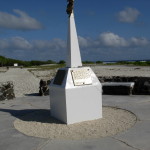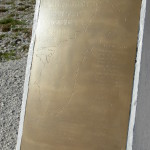Guam Memorial Rededication
 On June 8, 2017, the renovated Guam memorial was rededicated on Wake Island. Col. Frank Flores, Pacific Air Forces Regional Support Center commander, and Capt. Allen Jaime, Wake Island Detachment 1 commander, unveiled the new memorial stone during the rededication ceremony. The refurbished memorial had personal significance for Col. Flores, a proud native of Guam: “These men, with no military training, decided to take up arms and defend the island,” Flores said. “Their story was echoed by the feats of bravery and perseverance by the people of Guam, who on the island after the Japanese attack and invasion, continued to remain patriotic to our country, protect American servicemen on the island, and fought valiantly for their freedom.”
On June 8, 2017, the renovated Guam memorial was rededicated on Wake Island. Col. Frank Flores, Pacific Air Forces Regional Support Center commander, and Capt. Allen Jaime, Wake Island Detachment 1 commander, unveiled the new memorial stone during the rededication ceremony. The refurbished memorial had personal significance for Col. Flores, a proud native of Guam: “These men, with no military training, decided to take up arms and defend the island,” Flores said. “Their story was echoed by the feats of bravery and perseverance by the people of Guam, who on the island after the Japanese attack and invasion, continued to remain patriotic to our country, protect American servicemen on the island, and fought valiantly for their freedom.”
In addition to the civilian contractors and military personnel on Wake Island in December 1941, forty-five Chamorro employees of Pan American Airways were caught there by war. While Pan Am evacuated its American personnel on the bullet-ridden Clipper, the Chamorro employees were left on the island. Ten had perished in the initial attack and two more died later in POW camps. Fifty years later, a handful of aging survivors attended the dedication of the original Guam memorial in 1991. It was a simple plaque delicately engraved with the names of the men, but twenty years of exposure to the elements had degraded the plaque to the point of illegibility when I visited Wake in 2011. A few years ago I wrote about it in my post Guamanians on Wake, which offers more detail about the original memorial and the role of the Chamorros on Wake Island.
In one of his last letters from Wake Island, my grandfather described an evening at the Pan American lounge on Peale Island during which a number of the Chamorro employees entertained the guests with an impromptu performance. While Wake was officially “dry” for the civilian contractors, Harry Olson and a few others had open access to the Pan Am facilities, where they often socialized with management and Clipper visitors. In his letter dated November 30, 1941, Olson wrote about a long evening of dining and drinking a few days earlier as a farewell party for Peggy Frei, wife of the Pan American manager. (As tensions rose in the Pacific, the navy had ordered all civilian women on the outlying islands to evacuate, though the general opinion was that it was an unnecessary precaution.)
About midnite when everyone else was long in bed, we persuaded the Chamorro boys to put on one of their ceremonial sword dances. This is something. It’s a rhythmic sort of thing combining a little pure Jungle, some stately Spanish, with a dash of downbeat. As it’s done with sticks, it’s also noisy and everyone got up to see what was up. Mostly they were angry but soon got over it for the Chamorro boys were in dead earnest and going to town. It’s done to guitar music. The Chamorros have a lot of charm and a great gentleness. Ever sincere. One of them sang “Marie Elena” slightly off key and then came the payoff of the evening for me. The boy got up, bowed, and said, “I will now sing a song of farewell for Mrs. Free who is leaving tomorrow, perhaps forever.” We all started to smile until we looked at Peggy and saw the tears start. She was touched by this evidence of genuine affection. It was a sad song and its rendition sadder yet. Ordinarily one doesn’t do this sort of thing out here for we are here today and gone tomorrow and friendship a frail and transitory affair. Each of us lives in the present alone, forgets the past and awaits the future with what equanimity he can muster.
Building for War, 180-81
I have often wondered about who that young singer was and his fate. Four days later my grandfather would leave Wake on the east-bound Clipper for what was supposed to be a short vacation in Honolulu. Four days after that, Wake was at war. Japanese attacks across the Pacific had brutally erased whatever equanimity anyone had held.
The rededicated Guam memorial stands in its place on “Memorial Row” on Wake Island, facing the sea. The row is anchored on the south end by the tall, white U. S. Marine Corps memorial (dedicated in 1966), next is the Guam memorial, followed by the civilian contractors’ granite stone (1988), and the Japanese shrine (1957, with and the memorial stone from the original Japanese graveyard emplaced in 1966) on the north end. Many stop to pay their respects at Memorial Row and reflect on Wake Island’s role in U. S. history.
Earlier this month, en route home from a diplomatic mission to Australia, the Chairman of the Joint Chiefs of Staff, General Joseph, F. Dunford, USMC, arranged a fuel stop at the island to share Wake’s lesson with his staff. Landing early in the morning, they strapped on their running gear for a four-mile historical tour starting at the “POW Rock” on Wilkes, down the south beach and finishing at the memorials situated directly across from the terminal. Reflecting on the heroism of the defenders, General Dunford stated, “My commitment as we’re leaving here is we are not going to soil the colors on our watch. We’re proud to follow in your footsteps, we’re not going to let you down and we’re going to do you proud.”
May the World War II memorials long stand tall on Wake Island and the words inscribed on the Japanese shrine hold true: May Peace Prevail on the Waters of the Pacific Forever.
- Guam memorial detail, photo credit MSgt John Gordinier, 2017
- Guam Memorial rededication, photo credit MSgt John Gordinier, Alaska Command Public Affairs, 2017
- Memorial row on Wake Island, south to north: USMC (foreground), Guamanian (white block, left center), US Civilian (dark granite with low rock wall), Japanese (white block in distance)
- Original Guam Memorial




